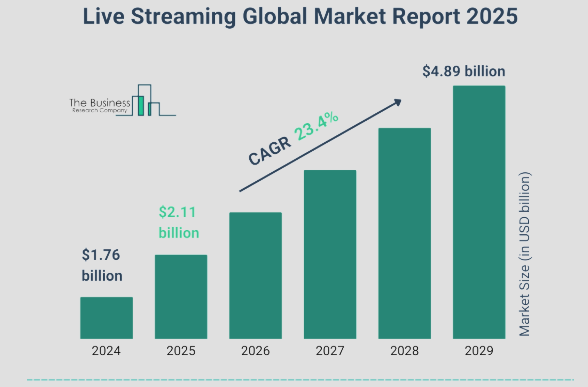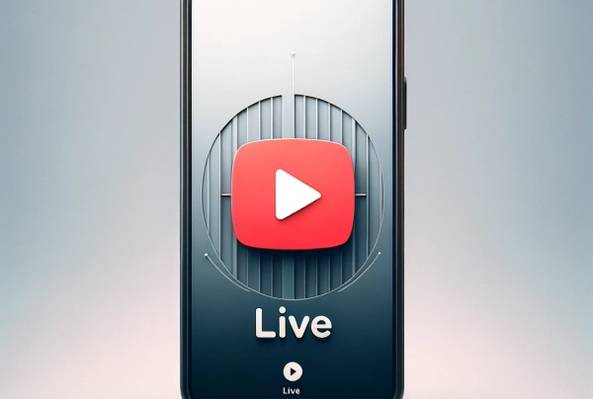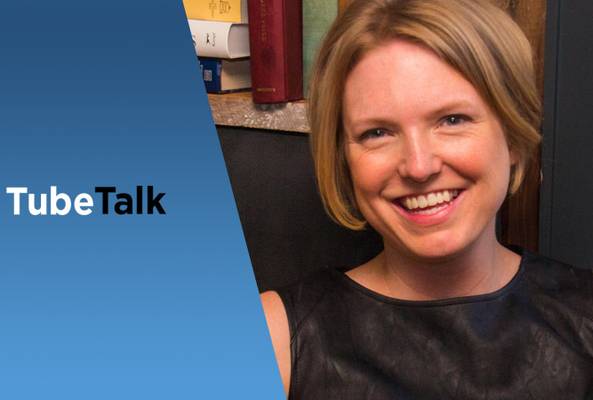In addition to being an avid movie and gaming enthusiast, Uttaran Samaddar is an experienced writer who has lent his creativity and unique perspective to various publications. He loves hearing and telling stories.
YouTube vs Twitch: The Best Choice in 2025
The live streaming market has been steadily increasing over the years and shows no signs of slowing down. According to a report by the Business Research company, it will increase from a market share of $1.76 billion to $2.11 billion this year, following a 19.7% CAGR.

And with nearly one-third of the world actively watching these platforms, the scope is huge!
As we navigate through 2025, two giants continue to dominate the streaming ecosystem: YouTube and Twitch. While both platforms offer powerful tools for creators, they serve distinctly different purposes and audiences.
Stop Guessing. Start Growing.
Join 20M+ creators using vidIQ to get more views, subscribers, and success on YouTube.
Read More: 6 Things to Do Before Your First YouTube Live Stream
The Fundamental Difference
The core distinction between YouTube and Twitch lies in their approach to content visibility and audience engagement. In the video below, Dan breaks down exactly how that manifests on the specific websites, so be sue to check it out!
Twitch: Built for the Live Moment
Twitch thrives on real-time interaction. It’s where your community shows up for you while you’re live. The energy is immediate, the audience is engaged, and the experience is immersive. But the downside? When you’re not live, your presence fades fast. Even with new tools like tags and clips, Twitch is still a platform that demands consistent, live availability to stay relevant.
If your strength lies in live performance and community engagement, Twitch makes sense. But know this: you’ll need to be present to stay seen.
YouTube: Long-Tail Discovery
YouTube flips the model. Live streams live on as searchable content, feeding an algorithm that keeps pushing your content to new viewers long after you hit "end stream." A strong video or stream on YouTube can keep paying dividends for months. You’re not just building for the now; you’re investing in content that grows legs.
This difference makes YouTube especially valuable if you want your content to be found organically, on viewers’ terms, not just while you're live.
Accessibility and Platform Reach
YouTube wins hands down when it comes to accessibility. It’s everywhere—smart TVs, consoles, phones, browsers. Viewers stumble across content casually, which is gold for discovery. Livestreams appear right next to regular videos, so users don’t need to dig for them.

Twitch, by contrast, is still a niche hub. You go there because you want to watch a stream. It’s less integrated into casual media consumption, which limits passive discovery.
YouTube's ubiquity gives it a significant edge in terms of accessibility. The platform is seamlessly integrated into virtually every digital device, from smart TVs and gaming consoles to smartphones and tablets. This universal presence means your content can reach viewers wherever they consume media.
Monetization Pathways
The financial aspect of streaming represents another crucial differentiator between these platforms, with each offering distinct approaches to creator compensation.

YouTube Monetization Model
YouTube has lowered its barriers to early monetization, creating more accessible entry points for emerging creators:
- Initial features like Super Chats and Channel Memberships unlock at just 500 subscribers and 3,000 watch hours
- Full partnership requires 1,000 subscribers and either 4,000 watch hours or 10 million Shorts views in the past 12 months
- Ad revenue splits heavily favor creators
- Content continues generating income long after publication
Perhaps most importantly, YouTube's monetization strength lies in the extended lifecycle of content. Streams that performed well live can continue generating ad revenue indefinitely as VODs, creating a compounding effect that builds sustainable income over time. Major creators like penguinz0 have reported YouTube ad revenue exceeding Twitch earnings by factors of 10x or more for identical content.
Twitch Monetization Approach
Twitch offers a more immediate path to initial monetization but with less favorable terms:
- Affiliate status requires just 50 followers and an average of 3 concurrent viewers
- Revenue splits are less generous at 50/50 for subscriptions
- Income generation effectively stops when streams end
- Bits (virtual currency for tipping) and direct donations supplement subscription income
The platform's advantage lies in its audience behavior. Twitch viewers are culturally conditioned to financially support creators through subscriptions, bits, and Prime Gaming benefits. This creates a more predictable income stream for established streamers with loyal communities.
Read More: Going Live on YouTube: 8 Genius Hacks for Monetizing Your Streams
The Multi-streaming Solution: Combining Platform Strengths
For many creators, the YouTube vs Twitch debate has evolved beyond choosing one platform over another. Multi-streaming, which is broadcasting simultaneously to both platforms, has emerged as a powerful strategy that leverages the strengths of each ecosystem while mitigating their weaknesses.

Tools like Restream and Stream Yard have simplified the technical challenges of broadcasting to multiple destinations, allowing creators to:
- Maintain their interactive Twitch community while gaining YouTube's discoverability
- Let audiences choose their preferred platform without forcing migration
- Increase overall reach by existing in multiple content ecosystems
- Build platform-specific audience engagement strategies
However, multi-streaming comes with potential drawbacks. Attention divided between multiple chat feeds can dilute engagement quality, and analytics become more complex to track and optimize. The strategy works best when creators have sufficient bandwidth—both technical and attentional—to manage multiple platforms effectively.
Creator Tools and Interactivity
Twitch maintains a significant advantage in terms of creator tools and interactive features. The platform's open API has fostered a rich ecosystem of third-party applications and extensions that enhance the streaming experience. This allows for advanced interactivity, including:
- Channel point redemptions that trigger on-stream events
- Audience-driven minigames and challenges
- Interactive overlays and alerts
- Community-created extensions
These tools facilitate a deeply immersive and participatory viewing experience that keeps audiences engaged throughout longer broadcasts.
YouTube, on the other hand, has made considerable strides in upgrading interactive capabilities too. They now offer:
- Live polls to gauge audience preferences
- Fundraising goals for charity streams or creator milestones
- Gifted memberships to promote community support
- Enhanced chat functionality with improved moderation tools
While these features have narrowed the gap with Twitch, YouTube still lacks the deeply embedded interactivity that makes Twitch streams feel like communal events rather than passive viewing experiences.
Platform-Specific Growth Strategies
Understanding the unique growth mechanics of each platform allows creators to optimize their approach whether choosing one platform or pursuing a multiplatform strategy.
Optimizing for Twitch Growth
Success on Twitch requires:
- Consistent scheduling to build viewing habits
- Heavy emphasis on chat interaction and community building
- Strategic use of collaborative streams to tap into established audiences
- Leveraging Twitch's newer discoverability features like tags and clips
- Creating memorable stream moments that encourage clip sharing
Optimizing for YouTube Growth
Maximizing YouTube's potential involves:
- Creating searchable, keyword-optimized titles and descriptions
- Developing content that works both live and as VODs
- Repurposing stream highlights into shorter, algorithm-friendly clips
- Maintaining a regular publishing cadence beyond just livestreams
- Utilizing YouTube Shorts as a discovery funnel for your main content
Make Your Choice
The YouTube vs Twitch debate doesn’t end with a clear winner; it ends with you. Your style, goals, and bandwidth all factor into the right call. Some creators go all in on one platform. Others multi-stream or even explore YouTube vs Twitch alternatives like Kick, Rumble, or Facebook Gaming.
Adaptability is the name of the game in 2025. The most successful creators don’t just ride trends they stay nimble, explore streaming platforms like Twitch, and meet their audiences wherever they are.
Meanwhile, check out these 5 tools that can improve your stream!
20k+ 5 Star Reviews
Ready to put this into action?
Use vidIQ to find your next video idea, pick better keywords, and optimize every upload.






